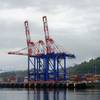Engineers in the Wastewater Management Branch at the Naval Surface Warfare Center's Carderock Division (NSWCCD) in Bethesda, Maryland assess, test and evaluate technologies for treating ship-generated graywater. Graywater consists of wastewater from showers, sinks, galley, scullery and laundry sources. The most recent accomplishment includes the design, fabrication, installation and initial testing of a shipboard graywater treatment system sponsored by NAVSEA 05R24. The equipment treats graywater generated by a crew of 75. It was installed on USS BONHOMME RICHARD (LHD 6) by an alteration installation team from the Environmental Improvement Section (Code 9153) at NSWCCD Ship Systems Engineering Station in Philadelphia, beginning continuous operation from June 2001 through September 2002 Addressing the unique requirements of the U.S. Navy, in recent years Carderock experts identified and developed the membrane bioreactor as the most promising technology for treating shipboard wastewater. The new graywater treatment system is based on the membrane bioreactor. Bacteria naturally present in the raw waste stream break down and consume organic material in the graywater. Membranes in the bioreactor provide a physical barrier retaining the bacteria and other solids while producing an effluent sufficiently clean to be discharged directly overboard. To ensure adequate treatment, an ultraviolet disinfection unit is employed in the system downstream of filtration. No chemicals are added with this technology. A 97% graywater volume reduction is achieved, reducing required holding capacity and waste offload costs while enhancing shore independence. This novel system was designed and fabricated culminating years of experience with membranes and membrane bioreactors in wastewater treatment, both in Carderock laboratories and pier side evaluations. Previous testing led to improvements in the treatment process, system hardware selection and automation features while at the same time advances in design and manufacturing of commercial membranes increased system ruggedness. NSWCCD engineers selected system pumps, valves and instrumentation after many hours of rigorous testing. The membrane bioreactor has clear advantages over existing commercial marine sanitation devices in efficiency and reduced complexity. Most are designed to reduce solids and bacteria in the waste stream, but do not the concentration of soluble organic matter. The membrane bioreactor reduces all three. Ship evaluation validates previous laboratory testing. Operation aboard BONHOMME RICHARD provides experience in a variety of ship operating scenarios, including in port, short underway periods and a 6-month deployment. In addition to the unit itself, two remote lift stations installed collect and supply graywater from a representative mix of sources to the graywater treatment system. The system collects and treats approximately 5-10% of the graywater generated overall and discharges the concentrated solids and clean effluent to the ship's tanks. The graywater treatment system is being developed for forward fit application. The LHD 6 installation marks its first Navy shipboard testing. Throughout the next 13 months testing will be conducted entirely by Carderock with no manning by the crew. The primary objectives cover validating the test protocols, demonstrating a 30-day solids holding time and showing that six months of continuous operation can be achieved without maintenance or operator intervention. During the initial operation of the graywater treatment system in June and July 2001, the system met both effluent quality and system throughput goals from the outset. - (By James E. Higgins, Naval Surface Warfare Center, Carderock Division.)
Featured videos

Tracking Foreign Vessels Working in the U.S. Jones Act Market

Inmarsat Enhances Service to Drive Digitalization

Unlock Onboard Data Efficiencies
Subscribe for
Maritime Reporter E-News
Maritime Reporter E-News is the maritime industry's largest circulation and most authoritative ENews Service, delivered to your Email five times per week








